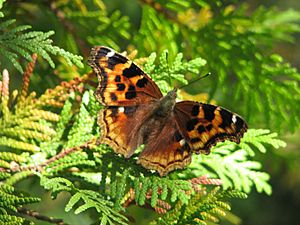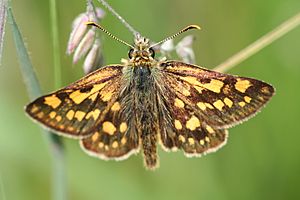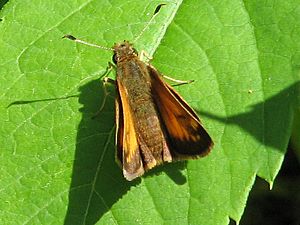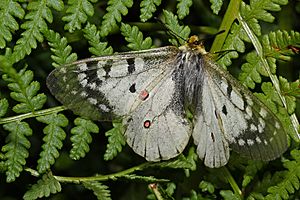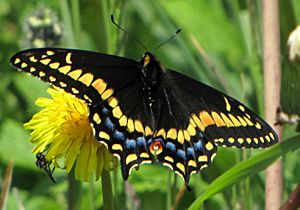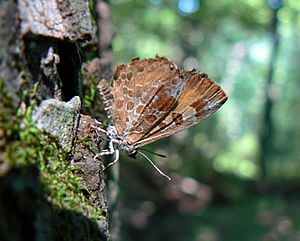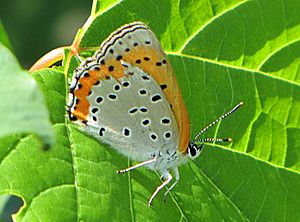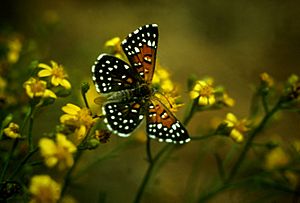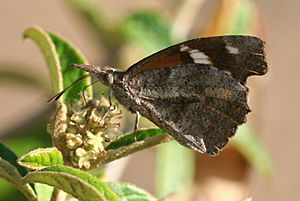List of butterflies of Canada facts for kids
Canada is home to many amazing creatures, including a wide variety of butterflies! These beautiful insects are important for our environment, helping to pollinate plants as they fly from flower to flower. This article will introduce you to some of the different types of butterflies you can find across Canada.
Contents
Skippers (Family Hesperiidae)
Skippers are a group of butterflies known for their quick, darting flight, almost like a tiny helicopter! They often have thick bodies and small wings, and their antennae usually have a hook at the end. There are many different kinds of skippers in Canada.
Pyrgine Skippers
These skippers are often called "duskywings" because of their duller, often brownish or grayish colors. They can be tricky to tell apart!
- Epargyreus clarus – silver-spotted skipper: This skipper has a bright silver spot on its hindwing.
- Urbanus proteus – long-tailed skipper: Look for its long, slender tails on its hindwings.
- Erynnis icelus – dreamy duskywing: A common duskywing, often seen in woodlands.
- Pyrgus communis – common checkered skipper: This one has a checkered pattern on its wings.
Intermediate Skippers
This small group includes the Arctic skipper.
- Carterocephalus palaemon – Arctic skipper: This skipper is found in northern areas and has a distinctive orange and brown pattern.
Branded Skippers
Branded skippers often have a "brand" or scent patch on their forewings, which helps males attract females.
- Ancyloxypha numitor – least skipper: As its name suggests, this is one of the smallest skippers.
- Thymelicus lineola – European skipper: This species was introduced to North America from Europe.
- Hesperia comma – common branded skipper: A widespread skipper with a clear "brand" mark.
- Polites peckius – Peck's skipper: This small skipper has a distinctive yellow patch on its hindwing.
- Poanes hobomok – Hobomok skipper: Often found in wooded areas, it has a bright orange color.
Parnassians and Swallowtails (Family Papilionidae)
This family includes some of the largest and most striking butterflies, known for their beautiful patterns and often "tails" on their hindwings.
Parnassians
Parnassians are usually white or pale yellow with black spots. They are often found in mountainous areas.
- Parnassius phoebus – Phoebus parnassian: A beautiful butterfly of high altitudes.
- Parnassius smintheus – Rocky Mountain parnassian: Found in the western mountains of Canada.
Swallowtails
Swallowtails are famous for the tail-like extensions on their hindwings, which resemble the tails of swallows.
- Papilio polyxenes – black swallowtail: A common black butterfly with yellow and blue spots.
- Papilio brevicauda – short-tailed swallowtail: Found in eastern Canada, with shorter tails than other swallowtails.
- Papilio glaucus – eastern tiger swallowtail: This large, yellow and black striped butterfly is a familiar sight.
- Papilio canadensis – Canadian tiger swallowtail: Very similar to the eastern tiger swallowtail, but found further north.
- Papilio multicaudatus – two-tailed swallowtail: This western species has two tails on each hindwing.
Whites and Sulphurs (Family Pieridae)
This family includes many common butterflies, often white, yellow, or orange. They are frequently seen in open fields and gardens.
Whites, Marbles, and Orangetips
These butterflies are usually white or have white as their main color, sometimes with colorful tips on their wings.
- Pontia protodice – checkered white: Named for its checkered wing pattern.
- Pieris rapae – cabbage white: A very common white butterfly, often seen in gardens.
- Euchloe ausonides – large marble: This butterfly has green marbling on its hindwings.
- Anthocharis sara – Pacific orangetip: Males have bright orange tips on their forewings.
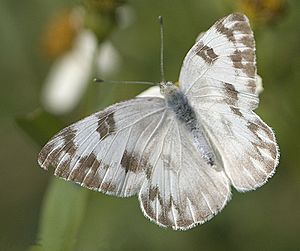
Sulphurs
Sulphurs are typically yellow or orange. They are often seen flying quickly over fields.
- Colias philodice – clouded sulphur: A common yellow butterfly, often with dark borders.
- Colias eurytheme – orange sulphur: Similar to the clouded sulphur but with more orange.
- Colias palaeno – Palaeno sulphur: Found in northern and arctic regions.
- Phoebis sennae – cloudless sulphur: A large, bright yellow butterfly that migrates north.
- Eurema lisa – little yellow: A small, delicate yellow butterfly.

Harvesters, Coppers, Hairstreaks, and Blues (Family Lycaenidae)
This is a very diverse family, often including smaller butterflies with delicate wings. Many have iridescent (shimmering) colors.
Harvesters
There is only one species of harvester in North America.
- Feniseca tarquinius – harvester: This unique butterfly eats aphids, unlike most butterflies that feed on plants.
Coppers
Coppers are small butterflies, often with bright orange, red, or coppery colors.
- Lycaena phlaeas – American copper: A small, bright copper-colored butterfly.
- Lycaena hyllus – bronze copper: This copper has a beautiful bronze sheen.
- Lycaena dorcas – dorcas copper: Found in bogs and wet areas.
Hairstreaks
Hairstreaks often have tiny, hair-like tails on their hindwings, which can look like antennae to confuse predators.
- Satyrium titus – coral hairstreak: Named for the coral-red spots on its hindwings.
- Satyrium calanus – banded hairstreak: Has a distinct band across its wings.
- Callophrys henrici – Henry's elfin: A small, brownish butterfly often seen early in spring.
- Strymon melinus – grey hairstreak: A common hairstreak with a gray color.
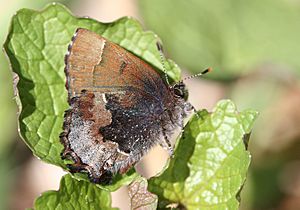
Blues
Blues are typically small butterflies with iridescent blue wings, especially the males.
- Cupido comyntas – eastern tailed-blue: Has small tails on its hindwings.
- Celastrina lucia – lucia azure: One of several similar "azure" blue butterflies.
- Glaucopsyche lygdamus – silvery blue: Named for the silvery sheen on its underside.
- Plebejus idas – northern blue: Found in northern parts of Canada.
Metalmarks (Family Riodinidae)
This family is small in Canada, with only one species. Metalmarks often have small, metallic-looking spots on their wings.
- Apodemia mormo – Mormon metalmark: The only metalmark species found in Canada.
Brush-footed Butterflies (Family Nymphalidae)
This is the largest family of butterflies, and they are called "brush-footed" because their front pair of legs are small and hairy, almost like brushes.
Snouts
This subfamily has a distinctive long "snout" formed by their mouthparts.
- Libytheana carinenta – American snout: Easily recognized by its long snout.
Fritillaries
Fritillaries are often orange or brown with black spots and markings. Many have silver spots on their undersides.
- Speyeria cybele – great spangled fritillary: A large, common fritillary with silver spots.
- Speyeria atlantis – Atlantis fritillary: Found in cooler, northern forests.
- Boloria selene – silver-bordered fritillary: A smaller fritillary with silver markings.
- Boloria polaris – Polaris fritillary: An arctic species, adapted to cold climates.
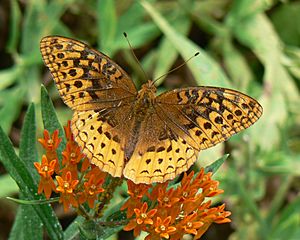
Angiewings, Tortoiseshells, Ladies, Checkerspots and Crescents
This diverse group includes many familiar butterflies.
- Polygonia interrogationis – question mark: Named for the silver mark on its hindwing.
- Nymphalis antiopa – mourning cloak: A large, dark butterfly with yellow borders, often seen early in spring.
- Vanessa cardui – painted lady: A well-known migratory butterfly found worldwide.
- Vanessa atalanta – red admiral: A striking black, red, and white butterfly.
- Junonia coenia – common buckeye: Has large, colorful "eyespots" on its wings.
- Phyciodes tharos – pearl crescent: A small, orange and black butterfly with crescent markings.
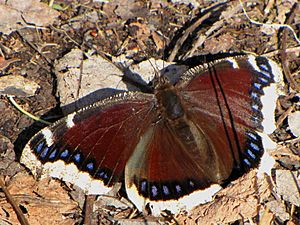
Admirals
Admirals are often dark with white bands, giving them a regal appearance.
- Limenitis arthemis – white admiral, red-spotted purple: This species has two forms, one with a white band and one with red spots.
- Limenitis archippus – viceroy: This butterfly mimics the monarch butterfly to protect itself from predators.
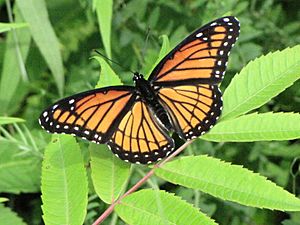
Emperors
Emperors are usually brownish butterflies, often with eyespots.
- Asterocampa celtis – hackberry emperor: Often found near hackberry trees, which their caterpillars eat.
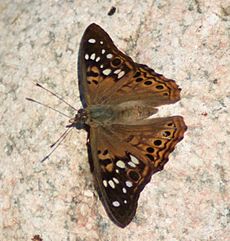
Satyrs and Wood-nymphs
These butterflies are typically brown or gray, often with prominent eyespots on their wings. They tend to fly in shady, wooded areas.
- Megisto cymela – little wood-satyr: A small, brown butterfly with eyespots.
- Cercyonis pegala – common wood-nymph: A larger brown butterfly with several eyespots.
- Erebia epipsodea – common alpine: Found in mountainous and northern regions.
- Oeneis jutta – Jutta arctic: An arctic species, well-adapted to cold environments.
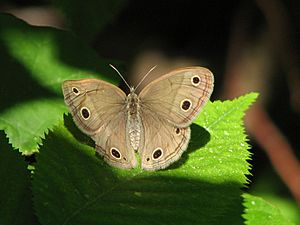
Milkweed Butterflies
This subfamily includes the famous monarch butterfly.
- Danaus plexippus – monarch: Known for its amazing long-distance migrations.
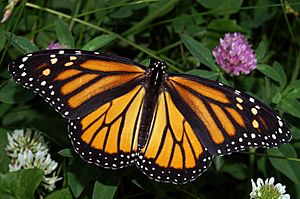
See also
- List of butterflies of North America
- List of moths of Canada
- List of damselflies of Canada
- List of dragonflies of Canada


